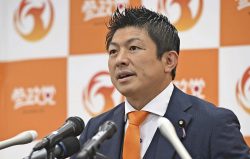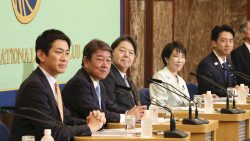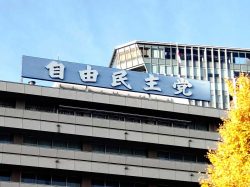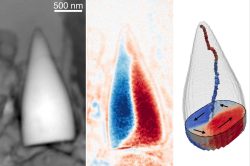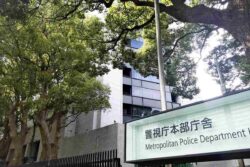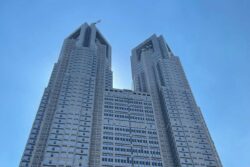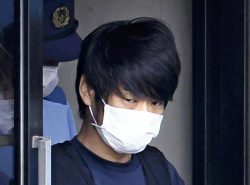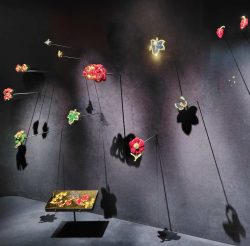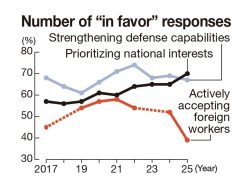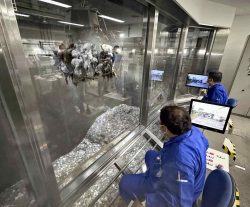Strategies Emerge Amid Campaign for Tokyo Governor; Koike Focuses on Official Duties, Renho on Speeches
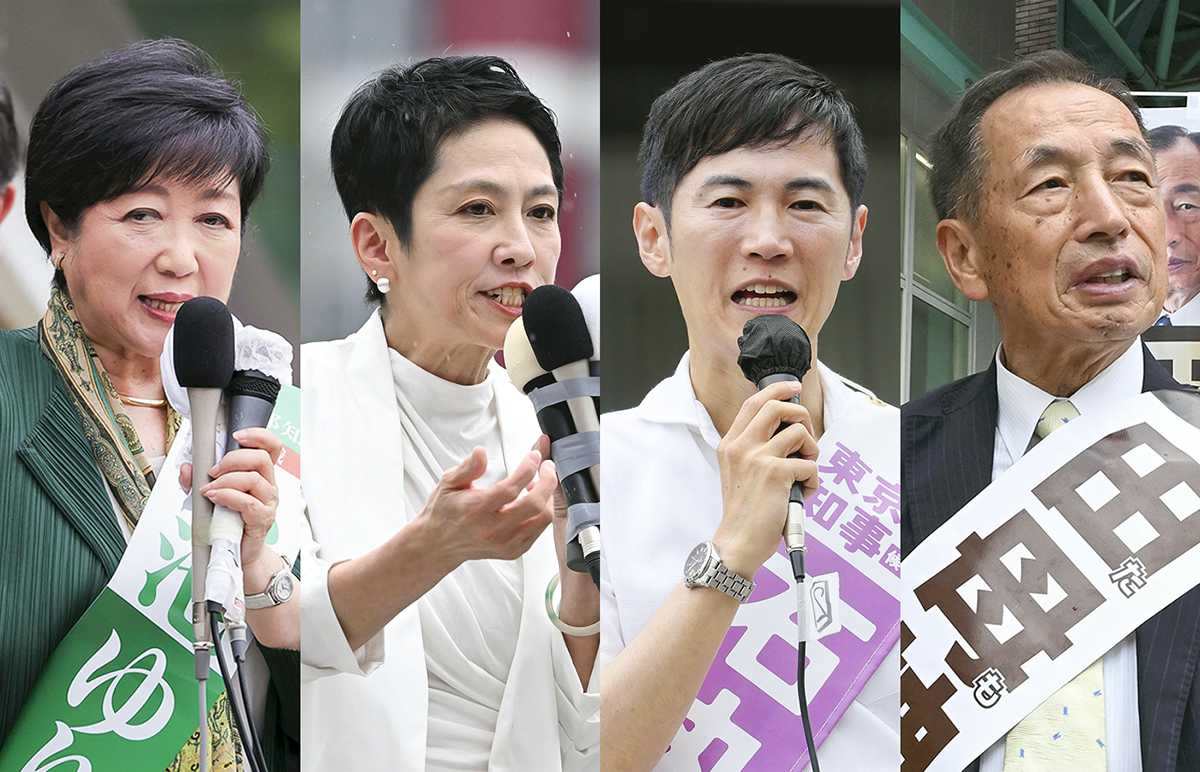
From left: Yuriko Koike, Renho, Shinji Ishimaru and Toshio Tamogami
18:29 JST, June 24, 2024
Candidates took to the streets in rainy weather to make speeches on Sunday, the first Sunday since the beginning of the campaign period for the July 7 Tokyo gubernatorial election.
A record 56 people are running, and their campaign strategies and goals have clearly emerged.
Koike utilizes inspection visits
Official campaigning started on Thursday, and Tokyo Gov. Yuriko Koike, 71, returned to the metropolitan government building after holding only a kickoff ceremony on that day. As to why she did not hold other campaign events, Koike cited the disruption created by a political group when she was making a speech in connection with the April by-election for Tokyo Constituency No. 15 in the House of Representatives.
However, it appears that she also wants to strengthen her support by presenting an incumbent-worthy image of prioritizing her official duties.
Koike’s official duties do not necessarily require her to be in her office at the metropolitan government building, and she can focus on inspecting various sites. She clearly aims to convey her messages, including her achievements over her two-term, eight-year stint as governor and the policies that she wants to promote in the future, through the media reports made by the journalists who accompany her on such occasions.
On Sunday, after inspecting a dam in the town of Okutama, Koike delivered speeches at two locations, including in front of JR Okutama Station. Referring to the damage caused by Typhoon No. 19 in 2019, Koike said, “I will protect the lives and livelihoods of Tokyo residents.”
The Liberal Democratic Party and Komeito, which will not field their own candidates in the election, are supporting Koike on their own initiative but staying behind the scenes. On Sunday, the only people who joined the governor in making speeches were heads of local governments, not local LDP lawmakers.
“We will not be at the front of the stage, but we’ve been approaching various organizations to support [Koike],” said a senior official of the Tokyo chapter of the LDP. “Our local members, especially metropolitan assembly members, are fully working to solidify her support base,” a Komeito official said.
Renho focuses on speeches
Renho, 56, a former member of the House of Councillors, is focusing on street rallies in bustling shopping areas. To avoid hurting her throat, Renho makes just one or two speeches a day, but she does a lot of the speaking at her rallies. These events are organized by the Constitutional Democratic Party of Japan, which she left just before the election.
Renho has emphasized her “anti-LDP stance.” On Friday, Renho criticized the LDP over some of its factions’ alleged violations of the Political Funds Control Law, during a campaign rally in the city of Hachioji, which is the hometown of Koichi Hagiuda, the chairman of the LDP’s Tokyo chapter.
However, the campaign presence of the Japanese Communist Party, which supports Renho, has been limited, as “people who don’t support any party will avoid [her] if there is too strong a left-wing atmosphere,” a person affiliated with Renho said. At a rally in front of Kinshicho Station in Sumida Ward on Sunday, JCP upper house member Yoshiko Kira joined Renho and spoke in her support.
“I want [Renho] to defeat the candidate who seeks the governorship of Tokyo with the LDP,” Kira said. This was the first time a JCP figure had stood next to Renho since the campaign started.
The communist side has been understanding of the circumstances of Renho’s campaign. “Each of the party members is calling for support for Renho at train stations and other places,” said a JCP official. “We’re doing even more campaign activity [for her] than for an official candidate.”
Ishimaru uses social media
The candidate most energetically taking to the streets is Shinji Ishimaru, the 41-year-old former mayor of Akitakata, Hiroshima Prefecture. Every day from morning to night, he moves from one speech location to another in 30-minute intervals, appealing for support.
Ishimaru is striving to boost his name recognition, and he spends much of his time introducing himself and his political stance. He has focused on specific targets in street campaigning —for example, visiting areas around universities and streets in old traditional districts.
On Sunday, Ishimaru held a rally in the Sugamo Jizo-dori shopping district — a popular spot among elderly people — in Toshima Ward. “Politics will change if a person who does not belong to an existing political party becomes governor of Tokyo,” Ishimaru said.
About 5,000 campaign volunteers are said to be spreading his activities through social media. He plans to put greater emphasis on specific policies in speeches.
Tamogami targets conservatives
Toshio Tamogami, 75, a former chief of staff of the Air Self-Defense Force, is determined to win over conservative voters. On the day official campaigning started, he visited Yasukuni Shrine in Chiyoda Ward, Tokyo, and made a speech in front of the Defense Ministry, his old workplace.
Figures who have spoken in support of Tamogami at his rallies since then have included members of conservative groups.
He has also emphasized policies for young people during rallies in bustling areas such as Harajuku in Shibuya Ward and Ikebukuro in Toshima Ward. On Sunday, he spoke in front of Kichijoji Station in Musashino, which is a popular place to live among young people.
“I want to increase the real income of young people,” Tamogami said. After the speech, he walked through the shopping district and accepted requests to take photographs.
"Politics" POPULAR ARTICLE
-
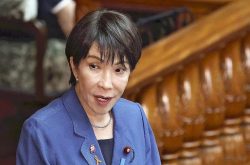
Japan to Charge Foreigners More for Residence Permits, Looking to Align with Western Countries
-
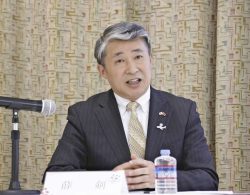
China Would Cut Off Takaichi’s ‘Filthy Head’ in Taiwan Crisis, Diplomat Allegedly Says in Online Post
-

If China Were to Impose Blockade on Taiwan, Existential Crisis Could Be Triggered, Japan’s Prime Minister Takaichi Says
-

Japan to Tighten Screening of Foreigners’ Residential Status by Providing Information of Nonpayment of Taxes
-

Takaichi Cabinet Approval Holds at 72% as Voters Back Aggressive Fiscal Stimulus, Child Benefits
JN ACCESS RANKING
-

Govt Plans to Urge Municipalities to Help Residents Cope with Rising Prices
-
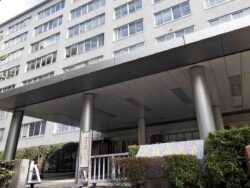
Japan Resumes Scallop Exports to China
-
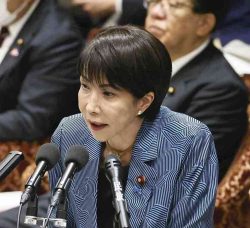
Japan Prime Minister Takaichi Vows to Have Country Exit Deflation, Closely Monitor Economic Indicators
-

Japan to Charge Foreigners More for Residence Permits, Looking to Align with Western Countries
-
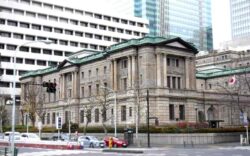
Japan GDP Down Annualized 1.8% in July-Sept.


